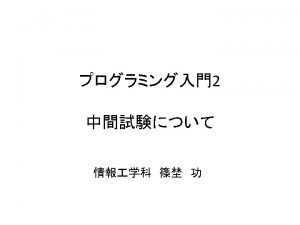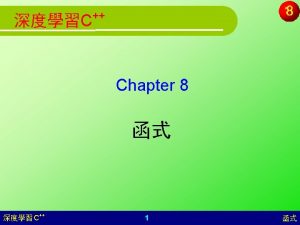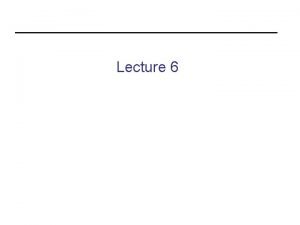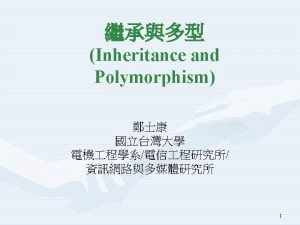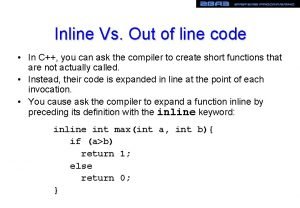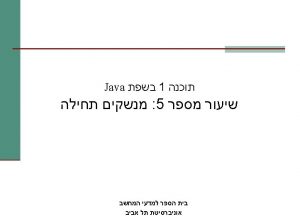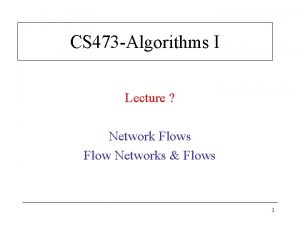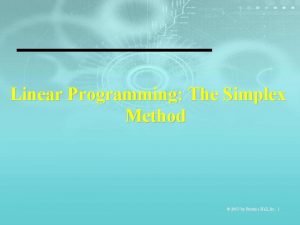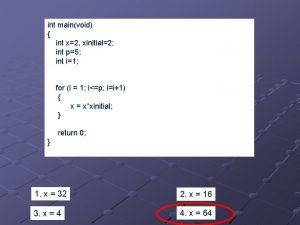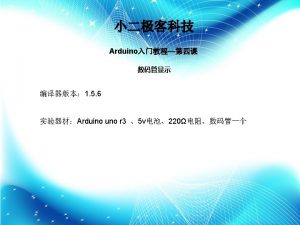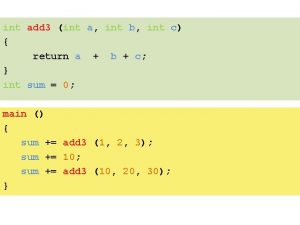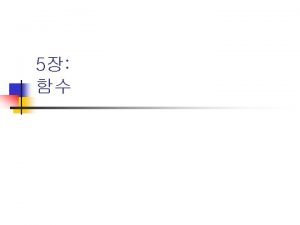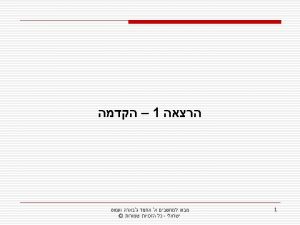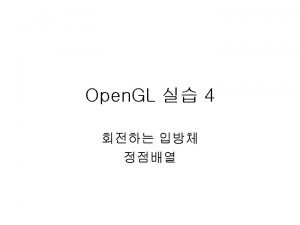int max 3int x int y int z

















![方法的调用 2、对象方法调用 � 于� 象方法,必� 先生成� 象� 例,然后用如下形式� 用方法: � 象名. 方法名([� 参]) class 方法的调用 2、对象方法调用 � 于� 象方法,必� 先生成� 象� 例,然后用如下形式� 用方法: � 象名. 方法名([� 参]) class](https://slidetodoc.com/presentation_image_h2/7ed5381bf68b536fb301255cf30d4652/image-18.jpg)





![方法的嵌套 public class Volume { public static void main(String args[ ]) { int i=5, 方法的嵌套 public class Volume { public static void main(String args[ ]) { int i=5,](https://slidetodoc.com/presentation_image_h2/7ed5381bf68b536fb301255cf30d4652/image-24.jpg)










- Slides: 34










方法的声明 § 例 求最大� 的方法 int max 3(int x, int y, int z) { int big; if(x>y) big=x; else big=y; if(big<z) big=z; return(big); }

方法的声明 § 例 无参方法示例 public void my_print( ) { System. out. println(“*”); System. out. println(“* * * *”); }




方法的调用 例 调用类方法 public class Square. C { static int square(int x) //类方法 { int s; s=x*x; return (s); } public static void main(String[] args) { int n = 5; int result; result= square(n); //类方法调用 System. out. println(result); } }

方法的调用 对于没有返回值的类方法,以独立语句的方式调用方法。 例: class Area. C { static void area(int a , int b ) { int s; s = a * b; System. out. println(s); } public static void main(String[] args) { int x = 5; int y=3; area(x, y); //方法� 句,直接� 用� 方法 } }

方法的调用 例 无参类方法调用 class Sum. C { static void sum( ) { int i, j, s; i=3; j=6; s=i+j; System. out. println(s); } public static void main(String[] args) { sum( ); } }
![方法的调用 2对象方法调用 于 象方法必 先生成 象 例然后用如下形式 用方法 象名 方法名 参 class 方法的调用 2、对象方法调用 � 于� 象方法,必� 先生成� 象� 例,然后用如下形式� 用方法: � 象名. 方法名([� 参]) class](https://slidetodoc.com/presentation_image_h2/7ed5381bf68b536fb301255cf30d4652/image-18.jpg)
方法的调用 2、对象方法调用 � 于� 象方法,必� 先生成� 象� 例,然后用如下形式� 用方法: � 象名. 方法名([� 参]) class My. Object { static int x=10; static int y=20; void method(int k, int m) { int sum; sum=k+m; System. out. println("sum="+sum); } public static void main(String args[]) { My. Object obj=new My. Object(); //生成对象 obj. method(x, y); //调用对象方法 } }

方法的调用 //对象方法(实例方法)调用示例: class Car { int speed; //变量定义部分。 float weight=12, height=2; //变量定义部分。 void chang. Speed(int new. Speed) //对象方法定义。 { speed=new. Speed; } float get. Weight() //对象方法定义。 { return weight; } float get. Height() //对象方法定义。 { return height; } public static void main(String args[]) { Car my. Car=new Car( ); my. Car. chang. Speed(120); System. out. println("车速度为: "+my. Car. speed); System. out. println("车的重量为:"+my. Car. get. Weight()); System. out. println(" 高度为:"+my. Car. get. Height()); } }

方法的调用 //对象方法(实例方法)调用示例:注意x, y的值是否变化?文件名如何命名? class Tom { void f(int x, double y) { x=x+1; y=y+1; System. out. println("参数x和y的值分别是: ”+x+” , ”+y); } } public class Example { public static void main(String args[]) { int x=10; double y=12. 58; Tom tom=new Tom(); tom. f(x, y); System. out. println("main方法中x和y的值仍然分别是: “+x+” , ”+y); } }

参数的传递 参数传递要点:虚实结合“三一致”原则即实参与虚参个数、 类型、顺序一致。 例4 -5 参数传递实例 public class Swaping { static void swap(int x , int y ) { int temp ; temp = x; x = y; y = temp; } public static void main(String[] args) { int u=23 , v=100; System. out. println("Before Calling"); System. out. println("u= "+u+" v= "+v); swap(u, v); System. out. println("After Calling"); System. out. println("u= "+u+" v= "+v); } }

参数的传递 class Lader { double above, bottom, height; public void set. Above(double a) { above=a; } public void set. Bottom(double b) { bottom=b; } public void set. Height(double h) { height=h; } double compute. Area() { return (above+bottom)*height/2. 0; } } public class Example { public static void main(String args[]) { double area=0; Lader lader. One=new Lader(); lader. One. set. Above(10); lader. One. set. Bottom(40); lader. One. set. Height(2); area=lader. One. compute. Area (); System. out. println("lader. One 的面积是: "+area); } }

![方法的嵌套 public class Volume public static void mainString args int i5 方法的嵌套 public class Volume { public static void main(String args[ ]) { int i=5,](https://slidetodoc.com/presentation_image_h2/7ed5381bf68b536fb301255cf30d4652/image-24.jpg)
方法的嵌套 public class Volume { public static void main(String args[ ]) { int i=5, j=6, k=7, v; v=vol(i, j, k); System. out. println("立方体的体积为:"+v); } static int vol(int a, int b, int c) { return(a*area(b, c)); } static int area(int x, int y) { return(x*y); } } //求体积的vol()方法 //求面积的area()方法



递归 § class Factorial § { § static long fac( int n ) § { § if (n==1 ) § return 1; § else § return n*fac(n-1); § } § public static void main(String[] args) § { § int k ; § long f; § k=25; § f=fac(k); § System. out. println(f); § }

递归 § 例: Fibonacci数列是这样的一列数: 1,1,2,3,5,8,13,21,34,55,…… 第n个Fibonacci数的递归描述为: public class Fibo { public static void main(String args[ ]) { for(int i=1; i<=20; i++) { System. out. print(f(i)+" "); if (i%10= =0)System. out. println(); } } static int f(int n) { if(n= =1||n= =2)return 1; else return(f(n-2)+f(n-1)); } }






 Int max(int x int y)
Int max(int x int y) Sum0
Sum0 Int.max
Int.max Public void drawsquare(int x, int y, int len)
Public void drawsquare(int x, int y, int len) Divideint
Divideint Interface calculator public int add class test
Interface calculator public int add class test Absolute max vs local max
Absolute max vs local max Max int c++
Max int c++ Maxint
Maxint Int factorial(int n)
Int factorial(int n) Void swap
Void swap Interface myinterface int foo(int x)
Interface myinterface int foo(int x) Void
Void Const int arduino adalah
Const int arduino adalah Int main(int argc, char** argv)
Int main(int argc, char** argv) Mainint
Mainint Int main() int num=4
Int main() int num=4 Disadvantages of bureaucracy by max weber
Disadvantages of bureaucracy by max weber Frotáž umělci
Frotáž umělci Pr max budowski
Pr max budowski Flow g cut
Flow g cut Max weber bureaucracy characteristics
Max weber bureaucracy characteristics Alireza akhavan github
Alireza akhavan github Altera
Altera Alienação marx
Alienação marx Max hickey
Max hickey Hermeneutic phenomenology
Hermeneutic phenomenology Pr max budowski
Pr max budowski Max's restaurant value proposition
Max's restaurant value proposition Max z = 3x1 + 5x2 metodo simplex
Max z = 3x1 + 5x2 metodo simplex Max wertheimer gestalt psychology
Max wertheimer gestalt psychology Max weber zhaw
Max weber zhaw Political democracy cartoon
Political democracy cartoon Omega plus max
Omega plus max

